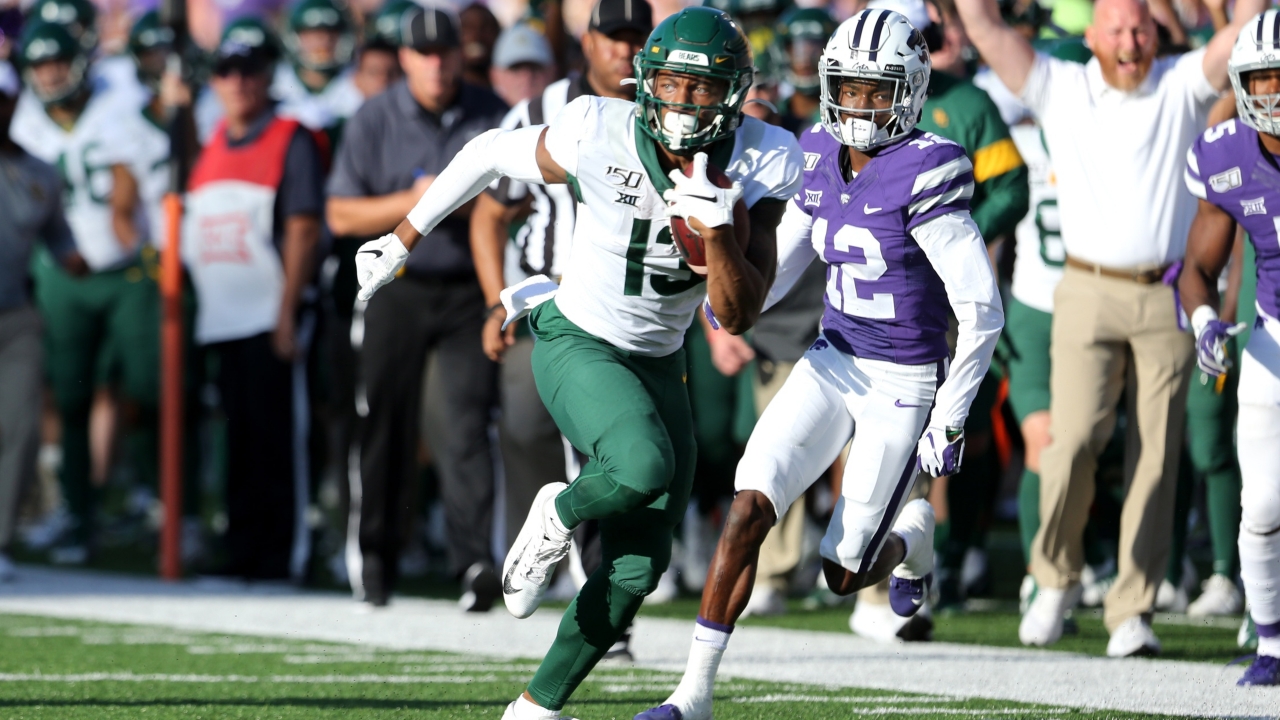
S11: A statistical overview of the Big 12 through week eight
New Member Special: Try SicEm365 Premium for $5.00 until Dec. 31
Big 12 Mid-Season Stats Review
As Baylor has a bye week I figured this would be a good time to look at how well different Big 12 teams stack up in a few key categories and provide some context to how good, bad, or average those numbers are. We’ll be looking at some statistics like yards per drive, red zone points, explosive play percentages, and more.
The following stats will mainly focus on games against Power 5 teams as usually those are a step up. Obviously some teams like SMU, pre-redshirt Houston, and others can be decent games to look at but to keep it consistent I am looking at P5 games.
Yardage and Field Position
On the following chart you see each team’s average yards per drive figure against Power 5 opponents in the colored bar and the yards per drive they allow in gray. Also pictured is a semi-transparent bar indicating which teams typically held an advantage in average starting field position and how many “hidden yards” they benefit from.
Why per drive instead of per game or per play? Per game is inflated or hindered by play count and per play can skew with how many big plays you hit. Per drive provides a fair metric for how well you move the ball while you have it. It simply answers the question - Did you move it while you had possession?
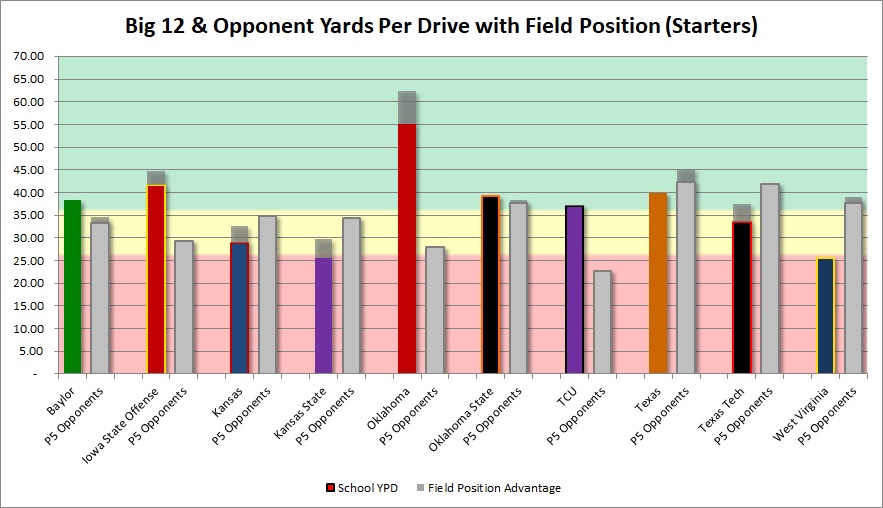
Here we see that Oklahoma is by far the most dominant performer so far. Their average advantage is 55 yards per drive to 28 but when you add over 7 yards of starting field position help it’s downright brutal. The weakest performer so far has been WVU who is really weighed down by their lopsided matchups with Mizzou, OU, and ISU. TCU is a surprisingly strong performer here with their blowouts of KU and a Purdue team starting a new QB at the time pushing the margins up. ISU, Baylor, and Oklahoma State are also on the positive side of this.
Comparing Yards
Next we take a closer look at the offenses against P5 opponents and how their results compare to what other Power 5 teams averaged against the same teams.
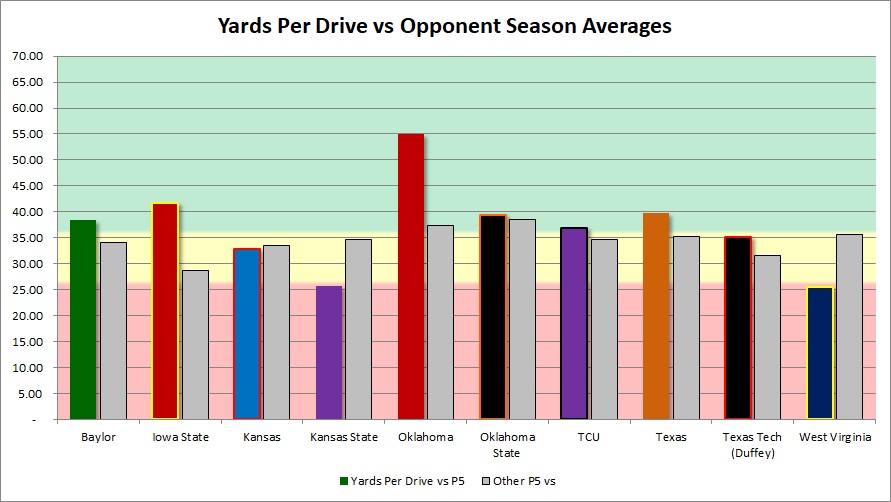
Once again OU is way out in front to nobody’s surprise. Their slate of opposing defenses averages giving up good days to offenses but OU outpaces that by a solid 17 yards per drive which is incredibly productive. Baylor, ISU, Tech, TCU, and Oklahoma State all are averaging more than what is expected. WVU, KSU, and KU are below par here.
Next we take a look at the defense with the same breakout.

Here the best performer is TCU while Baylor, Iowa State, Oklahoma, KSU, and WVU are all doing well compared to expectations. WV is mainly beating par off the strength of their UT game where they held the Longhorns almost 15 yards below what they averaged against other P5 teams. Without that the Mountaineers are slightly worse than expectations but not by a lot.
The worst performer here is KU although the team most would have been shocked to see here before the season is Texas who is giving up over 40 yards per drive against teams that collectively average less than 40. OSU and Tech are also struggling defensively in yards per drive but each has had one or two games where they performed really well against par.
Red Zone Scoring
Next we compare how well teams convert red zone opportunities into points. Simply scoring in the red zone isn’t enough so tracking what percentage of drives end in any score is pretty meaningless. A middle of the road performance is 5 points per trip (alternating a touchdown and field goal) while kicking a field goal each time would be very poor. Below is an estimation of points per trip- all touchdowns are assumed to be worth 7 and all field goals 3 and then divided by the number of trips. Both offensive results (colored bars) and defensive points per trip allowed (gray bars) are shown.

The clear winner in the red zone so far has been Texas. They average six per trip while holding opponents well below average. ISU is slightly behind them but also out in front. WVU and Tech are struggling here. The rest of the league is somewhere in the middle while TCU has given up a lot in the red zone which surprised me.
Explosive Plays
Long plays can change a game in a heartbeat and defenses preach daily about preventing them. Below is a comparison of what percentage of an offense’s plays or defense’s plays go for 20+ yards.
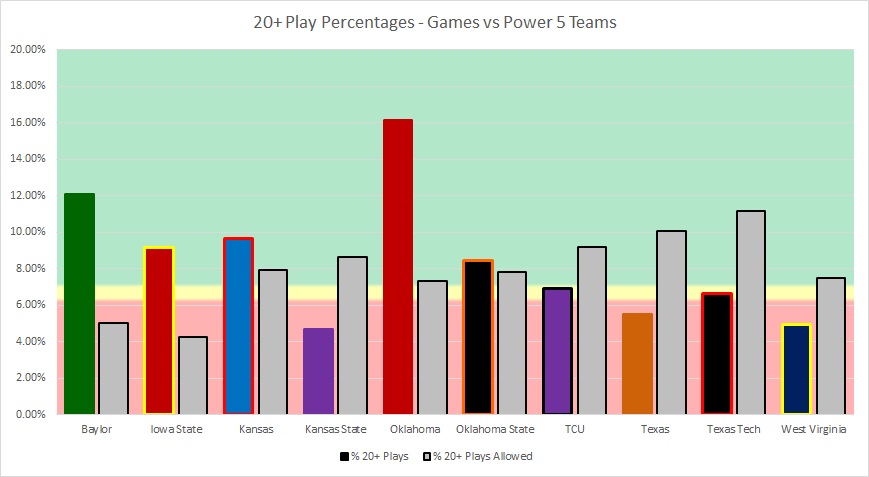
Here the teams winning the explosive play differential the most are Oklahoma, Baylor, and Iowa State. Kansas and Oklahoma State are doing so as well but by a smaller margin. Everyone else is losing that comparison. One caveat is that Tech’s explosive plays allowed figure is potentially due to their schedule that includes four of the five best explosive offenses in the conference and Arizona who has been explosive as well.
Texas hasn’t been a very explosive offense but that was true last year (6.2%) and that part isn’t necessarily a reason to worry. Their defense however only gave up 5% last fall and aren’t anywhere close to that figure this year. TCU has been prone to giving up some big plays as well.
When you isolate it to just big plays in the air you can see a bigger divide between tactics and their results. Below is the percentage of adjusted pass attempts (attempts including sacks) that went for 20+ yards. So it’s similar to the above but specifically focused on the passing game.
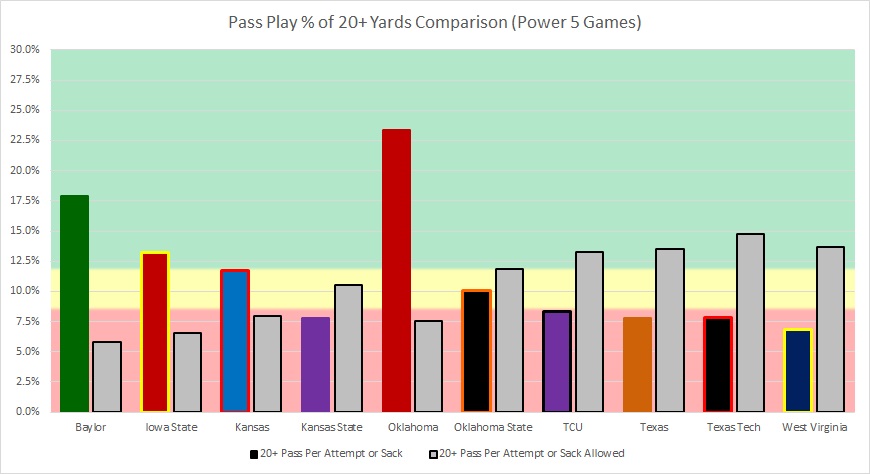
Oklahoma is the most explosive but Baylor is also far ahead of many in the Big 12. ISU and KU also post good figures while Oklahoma State has been average while adjusting to a new QB and teams rolling coverages to Tylan Wallace.
Defensively Baylor, Iowa State, Kansas, and Oklahoma are all doing fairly well limiting big passing plays. However the aggressive tactics of UT, OSU, Tech, TCU, and WVU are giving up a lot of big plays in the air.
Passing Game
In the air many fans like to look at yards per attempt. My only concern here is that sacks are also passing plays. Below is a look at yards per attempt including sacks but I have also used a semi-transparent indicator to show what the non-adjusted figure would have been. It helps to show how much impact the protection is having to an extent.
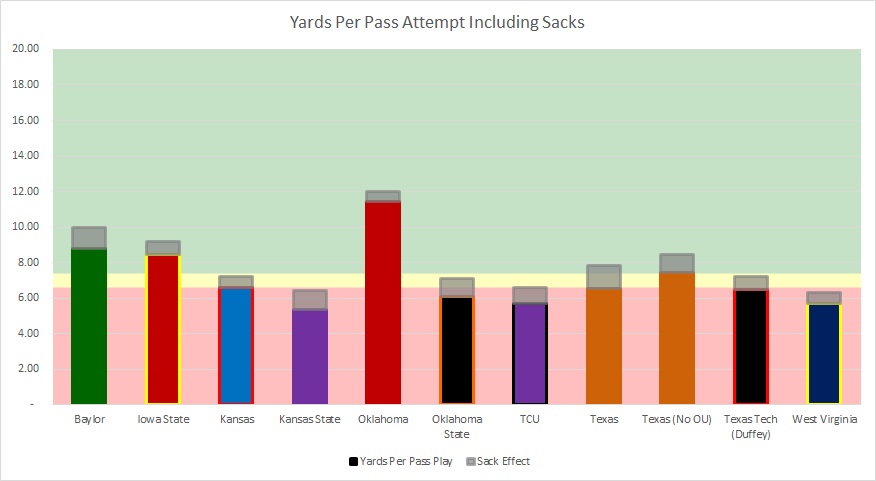
It’s not shocking that Baylor, ISU, OU, and Texas are the best performers here as they all have veteran Quarterback play. This number is lower than expected for UT but a severe anomaly in the Cotton Bowl (3.34 per pass play) is tanking UT’s average by about a yard. KU and Tech aren’t lighting the world on fire in the air but are solid with veterans who have rotated in as starters off and on in their careers. Kansas State has an experienced QB but has had personnel issues at receiver hold them back a bit. TCU and WVU have been inconsistent despite some athletic skill weapons to throw to. Defensive numbers for this statistic are below.
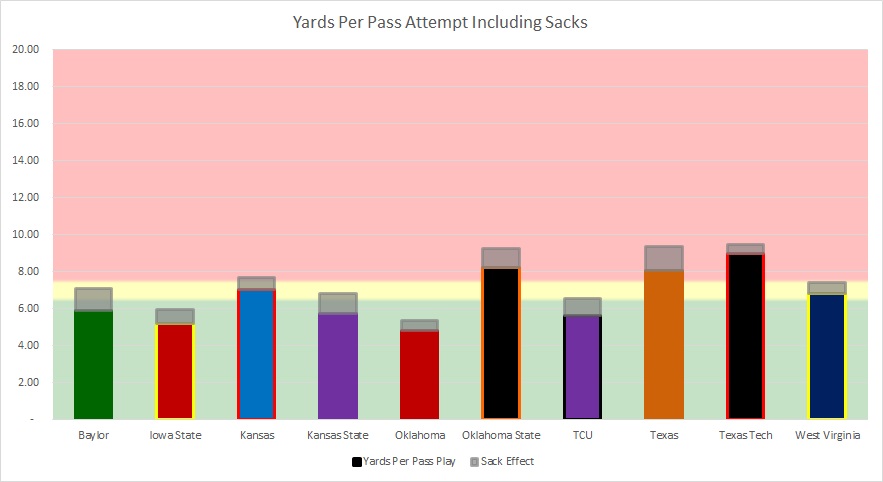
The Oklahoma Sooners, TCU Horned Frogs, Baylor Bears, Kansas State Wildcats, and Iowa State Cyclones all do well here. The Texas Longhorns, OSU Cowboys, and Texas Tech Red Raiders all struggle here but partly I think schedule plays a role there as LSU, OU, Baylor, and ISU all can be tough to limit this year.
The Ground Game
Yards per carry is a commonly used statistic but can be heavily skewed by long runs. When a median run is around 3 yards one long run can inflate numbers significantly. The best running games are productive even without those plays in my opinion and therefore we have a view below that shows how much outlier runs (Loosely defined as 20+ yard carries) contribute to the yards per carry that a team generates from carries that aren’t team carries, QB carries, WR carries, or kicker/punter carries. Who is reliable and who is boom or bust? This is a quick and dirty way to estimate that and it also includes the results for each defense.
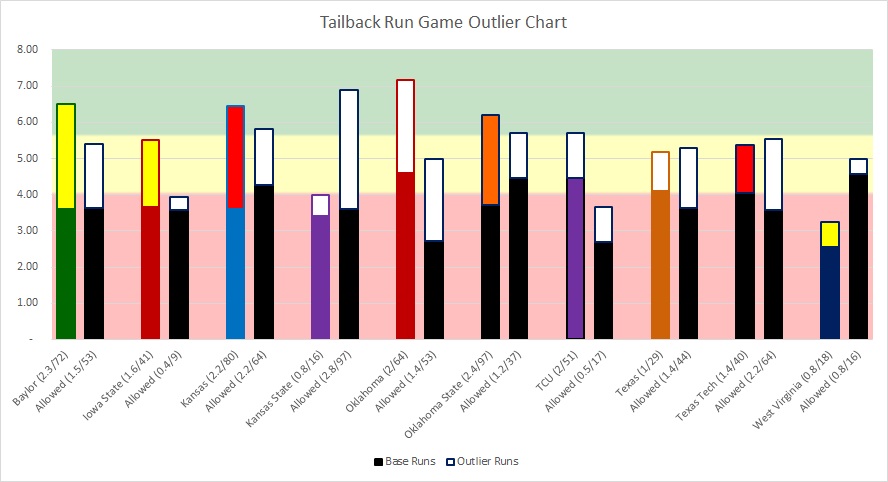
On the offensive side we see that the Oklahoma Sooners are predictably very good at their base yards per carry but also do a good job getting explosive plays as well. The Kansas Jayhawks, Baylor Bears, and OSU Cowboys are the three who lean towards boom or bust. The surprise for me is that TCU is very solid in yards per carry even after long carries are removed. ISU and Tech aren’t really producing much outside of outlier and don’t produce a ton of them either. WVU is struggling a lot while KSU has struggled to find room as their passing woes allow teams to load up against them.
Defensively the TCU Horned Frogs and Iowa State Cyclones do the best job of limiting the running backs they face and both do a decent job avoiding explosive runs. Kansas, Oklahoma State, and WVU are all struggling with your every down carries. KSU has performed poorly in giving up explosive carries but the massive game OSU hung on them is spiking that a bit as they limited TCU’s tailbacks from any 20+ carries.
Final Thoughts
There’s a lot to take in here but I do think it gives a quick picture of the ten teams.
- The Oklahoma Sooners have finally improved on defense. This year will be the first time since 2016 where OU will NOT be 10th out of 10 for common opponent yards per drive allowed in the Big 12. They have done a great job so far with an attacking and disruptive group. They haven’t faced the better big play passing attacks in the league and giving up explosive passes on 14% of the attempts or sacks they faced against the two teams who have been consistently explosive in the air (UH and KU) indicates it might be an opening for future opponents to attack.
- The Sooners haven’t faced a really strong defense yet but look absolutely dominant so far. They are destroying the benchmarks you would expect but as I mentioned above- their P5 opponents average giving up almost 40 yards per drive to other P5 teams. The offense is it’s usual buzzsaw self however and any opponent is going to have to score a lot. Even if teams can burn OU for big plays it may not be enough. This team is thrashing people.
- Texas is a similarly productive but not terribly explosive offense they were last year and will be a difficult team to stop usually. The issue for them is the defense where the only great stat is their red zone points per trip. Giving up big plays is the big liability so far and that caused a lot of problems against LSU, OU, WVU, and KU.
- The team that seems to be the better than their record is TCU. Their yards per drive is solid enough on both sides of the ball, they run decently well, and they defend the run well. They have to get better in the passing game and stop giving up big pass plays though as that can put you behind quickly in this league.
- Oklahoma State is a very explosive but hit or miss run team and a potentially explosive passing game once Sanders matures a little bit and they get the other guys to take some of the coverage away from Wallace. Their defense has issues both with base run plays and giving up big plays in general. OSU is a good team but is caught in a young year on defense.
- Iowa State and Baylor are both very strong this year with winning differentials in yards per drive, explosive play differential, and pair strong defenses with playmakers at QB.
- Texas Tech has faced five of the six most explosive passing attacks they will face in their ten Power 5 games and faced three of the best defenses they will face. With those elements of the schedule lightening up in their final games I expect they will get the three wins they need for a bowl. Their offense has been solid with Duffey and the defense has been mostly average vs par outside of OU’s pasting of them.
- Kansas should be the most entertaining team to not make a bowl this year. They produce big plays and outside of the WVU game have given up a lot of them. It won't be enough for a bowl but when you have that many big plays you can pull an upset or two- ask Boston College.
- Kansas State has been decent on defense in most of the stats outside of Chuba Hubbard's big runs but is really struggling to move the ball. Their issues in the passing game are making it tough for a solid offensive line to get things going on the ground and the whole thing grinds to a halt. Their ability to get an edge in field position is critical and played a role in their defeat of TCU which might have been the critical game to keep bowl hopes strong.
- West Virginia is in a rebuild and the offense is exhibit A. They struggle to run, struggle to throw, and have struggled to generate big plays against teams other than Texas and NC State with only 2.68% in their other games including JMU. Their defense is further along than the offense but both have a ways to go in a year where the roster is down. With that said they can easily upset someone on a given day and gave UT a scare for over three quarters.
With some big matchups involving the better teams in the conference facing off against each other the season should end on an exciting note.
Follow @Baylor_S11 on Twitter!




